Domestic Water Buffalo
- January 30, 2024
- 0 comment
The Domestic Water Buffalo (Bubalus bubalis) is a remarkable and versatile animal, deeply ingrained in the agricultural and cultural fabric of many regions across the world, particularly in South Asia, Southeast Asia, and parts of Europe. Originating from the Indian subcontinent, these animals have been domesticated for thousands of years and are prized for their ability to adapt to diverse environments, ranging from wet marshlands to dry plains. There are two main types of Domestic Water Buffalo: the River Buffalo, known for its high milk production, and the Swamp Buffalo, primarily used for labor, especially in rice cultivation. These buffaloes are not just economic assets but also hold significant cultural value in many societies, often being associated with religious and social ceremonies.

Physically, they are robust and large, with distinct curved horns and a thick skin that helps them adapt to various climates. Their diet mainly consists of grass and other vegetation, making them integral to the agricultural ecosystems where they graze and work. In terms of production, the Domestic Water Buffalo is a vital source of dairy products, with its milk being richer in fat and protein than cow’s milk, and is also used for meat in some regions. Beyond their agricultural utility, these creatures are known for their docile temperament, although they require respectful handling due to their size and strength.
| Specification | Detail |
|---|---|
| Scientific Name | Bubalus bubalis |
| Common Name | Domestic Water Buffalo |
| Type | Mammal |
| Family | Bovidae |
| Native Range | South Asia, Southeast Asia, extended to other regions |
| Lifespan | Typically 18-25 years, can vary based on breed and environment |
| Body Length | Approximately 2.4 to 3 meters (8 to 10 feet) |
| Shoulder Height | About 1.5 to 1.8 meters (5 to 6 feet) |
| Weight | 400 to 1200 kg (880 to 2640 lbs), depending on breed |
| Types | River Buffalo and Swamp Buffalo |
| Coat | Thick, coarse skin with sparse hair |
| Color | Mostly grey or black |
| Horns | Large, crescent-shaped, can span up to 2 meters |
| Diet | Herbivore, mainly grass and aquatic plants |
| Usage | Dairy production, labor (plowing, transportation), meat |
| Temperament | Generally docile, calm but can be aggressive if provoked |
| Reproductive Age | Females: 2-3 years, Males: 3-4 years |
| Gestation Period | Approximately 10 to 11 months |
| Milk Production | Varies by breed, generally 5-12 liters/day for dairy breeds |
| Environmental Impact | Methane producer, requires significant water for upkeep |
| Conservation Status | Not endangered, domesticated widely; wild counterparts at risk |
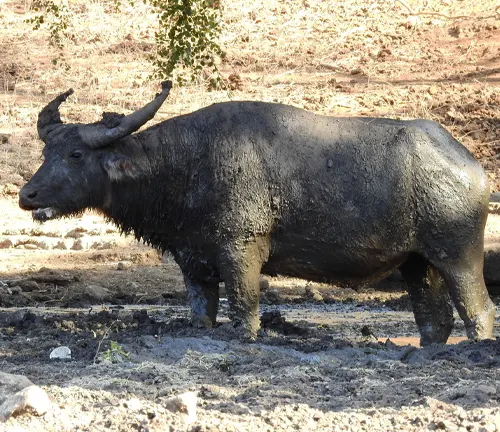
The Domestic Water Buffalo (Bubalus bubalis), a gentle giant revered in many cultures, stands as a testament to the symbiotic relationship between humans and animals. Originating from regions in South Asia, this majestic creature has journeyed across continents, adapting and becoming integral to various agricultural and cultural landscapes.
Historical Background
Origin and Domestication
Delving into the past, the domestication of the water buffalo dates back thousands of years. It’s a tale of human ingenuity and the transformation of a wild species into a cornerstone of rural life.
Spread Across Continents
From the lush valleys of the Indus to the farms of Italy, the water buffalo’s migration is a story of adaptation and resilience, illustrating its versatility and robustness.
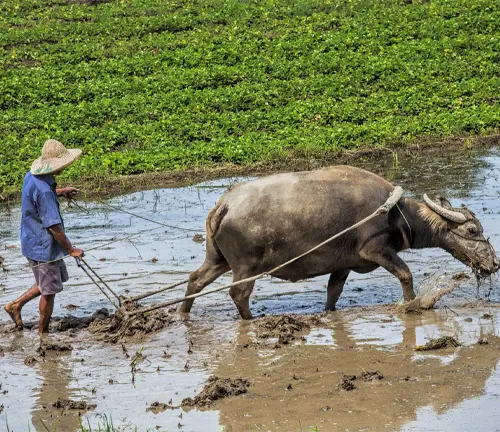
Physical Characteristics
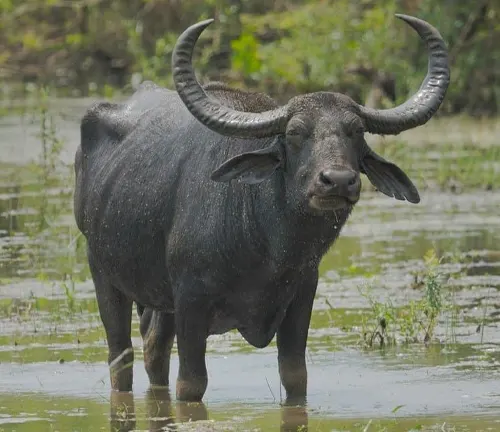
Size and Appearance
Imagine a creature of immense stature, with eyes that tell tales of the fields and waters they’ve traversed. The water buffalo’s size and appearance are not just physical traits but a mirror of their life’s journey.
Unique Physical Traits
Each curve of the horn, each ripple of muscle, is a testament to their role in the tapestry of agriculture and culture.
Habitat and Diet
Natural Habitat
Picture the ideal home for these creatures: vast, open fields, and meandering rivers. Their natural habitat is a sanctuary, a place of sustenance and peace.
Dietary Habits
Their diet is simple yet vital, a harmony of nature’s offerings sustaining these giants and, in turn, the communities they support.

Role in Agriculture
Dairy Production
The milk of the water buffalo is not just a product; it’s a source of nourishment, a key ingredient in culinary traditions, and a lifeline for many farmers.
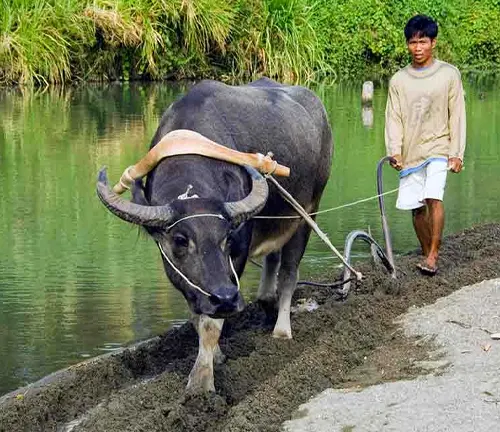
Labor and Transportation
Beyond dairy, they are the unsung heroes of rural transport and labor, their strength harnessed in fields and on roads, a testament to their enduring partnership with humans.
Cultural Significance
In Religion and Society
More than animals, they are symbols and guardians in the tapestry of many cultures, revered in religion, and celebrated in society.
Festivals and Traditions
Festivals and traditions across continents pay homage to these creatures, a celebration of their contribution to human life.

Health and Veterinary Care
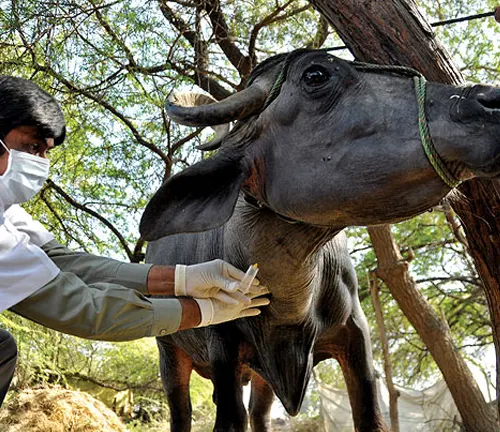
Common Health Issues
Like all living beings, they too face health challenges, each ailment a hurdle in their journey, a reminder of the need for care and understanding.
Veterinary Practices
The art and science of veterinary care, a field dedicated to ensuring their well-being, is a testament to our responsibility towards these gentle giants.
Conservation and Challenges
Conservation Status
Conservation is not just a duty but a moral imperative, an effort to protect and preserve these creatures for future generations.
Environmental and Economic Challenges
Facing environmental and economic challenges, the story of the water buffalo is a call to action, a reminder of the delicate balance we must maintain.
Economic Importance
Global Economic Impact
Their economic impact is global, a ripple effect from rural farms to international markets.
Trade and Commerce
Trade and commerce in water buffalo products are not just transactions; they are exchanges in a global narrative of sustenance and livelihood.
Different Species
River Buffalo (Bubalus bubalis bubalis)
Origin: The River Buffalo is believed to have originated in the Indian subcontinent and is extensively found in countries like India, Pakistan, and other parts of South Asia.
Characteristics: This type typically has a larger body size and longer, more curved horns. They are well-adapted to wet, marshy areas near rivers.
Usage: River Buffaloes are primarily used for milk production, and they are known for their high-quality and high-quantity milk yield. They are also used for draught purposes in some regions.
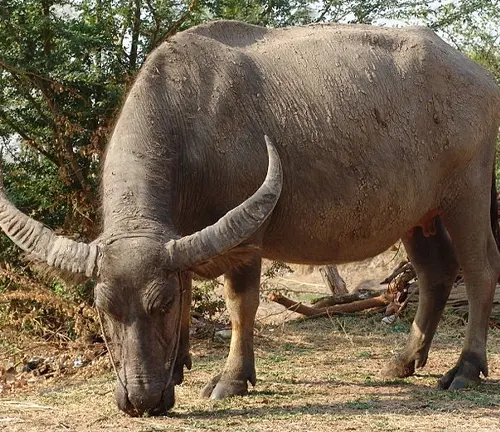
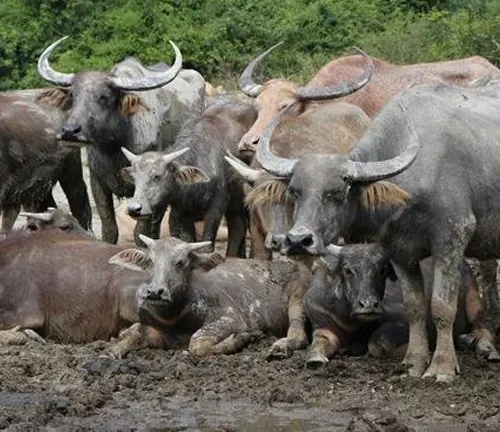
Swamp Buffalo (Bubalus bubalis carabanesis)
Origin: The Swamp Buffalo is native to Southeast Asia and is predominantly found in countries like the Philippines, Thailand, Vietnam, and Indonesia.
Characteristics: They are generally smaller in size compared to River Buffaloes and have shorter, sturdier horns. Adapted to swampy terrains, they are well-suited for tilling rice fields.
Usage: Swamp Buffaloes are primarily used for labor, particularly in rice cultivation. They are also used for meat production in some regions.
Frequently Asked Question (FAQs)
- What is the difference between River and Swamp Water Buffaloes?
River Buffaloes have longer, curved horns and are primarily used for milk production, especially in South Asia. Swamp Buffaloes, with shorter, straighter horns, are more commonly used for labor, particularly in rice cultivation in Southeast Asia. - What is the average lifespan of a Domestic Water Buffalo?
Domestic Water Buffaloes typically live for about 18 to 25 years, depending on factors like breed, living conditions, and health care. - How much milk can a Water Buffalo produce?
A River Buffalo, which is primarily used for dairy purposes, can produce about 5 to 12 liters of milk per day, with some high-yielding breeds producing even more. - Are Water Buffaloes dangerous?
Generally, Domestic Water Buffaloes are known for their docile nature, especially if they are raised in close proximity to humans from a young age. However, like any large animal, they can be dangerous if provoked or startled. - Can Water Buffaloes be used for meat production?
Yes, in addition to dairy and labor, Water Buffaloes are also reared for their meat, particularly in some Southeast Asian countries. - What do Water Buffaloes eat?
They primarily feed on grass and other vegetation. Their diet can include hay, fresh grass, and agricultural by-products, supplemented with minerals and vitamins if needed. - What is the environmental impact of rearing Water Buffaloes?
Water Buffaloes can have both positive and negative environmental impacts. They contribute to the agricultural ecosystem but also produce methane, a greenhouse gas. Their requirement for water and grazing can impact local ecosystems. - Are Water Buffaloes endangered?
Domestic Water Buffaloes are not endangered; they are widely bred and farmed. However, their wild counterparts, such as the Wild Asian Water Buffalo, are considered endangered due to habitat loss and hunting. - How do Water Buffaloes contribute to agriculture?
They are invaluable in many agricultural processes, including plowing fields, especially in wet conditions where they excel, and providing high-quality milk and meat. - Can Water Buffaloes be trained?
Yes, they are intelligent and can be trained for various tasks, including pulling carts and plowing fields, especially in regions where they are a vital part of the agricultural workforce.


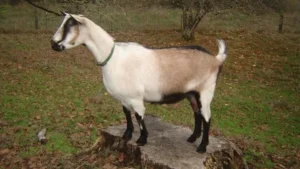
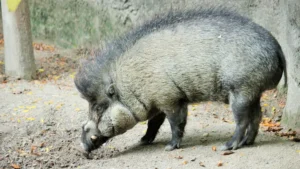

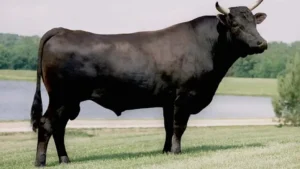



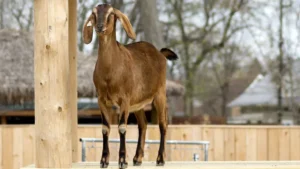
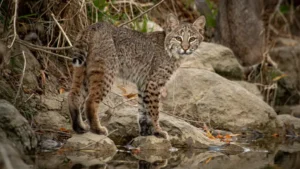

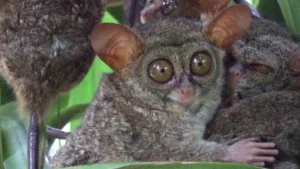

Leave your comment